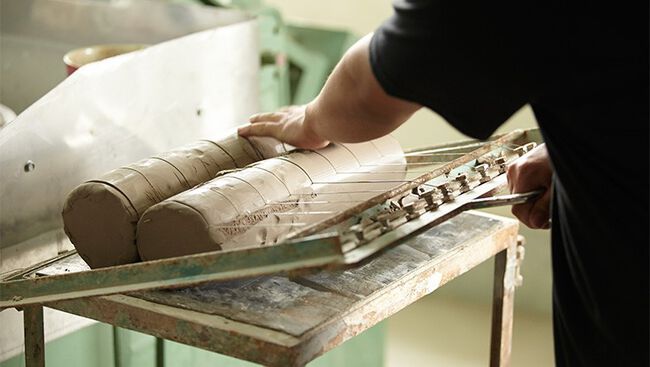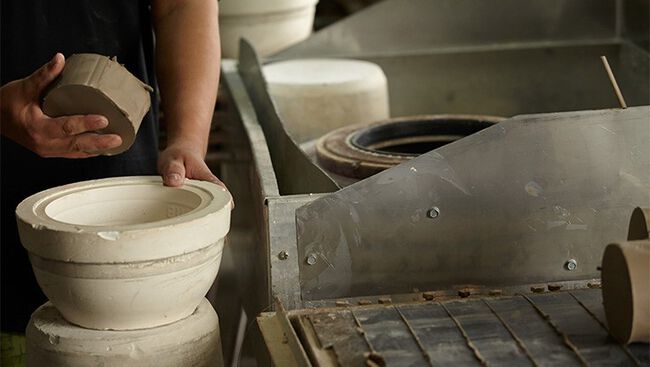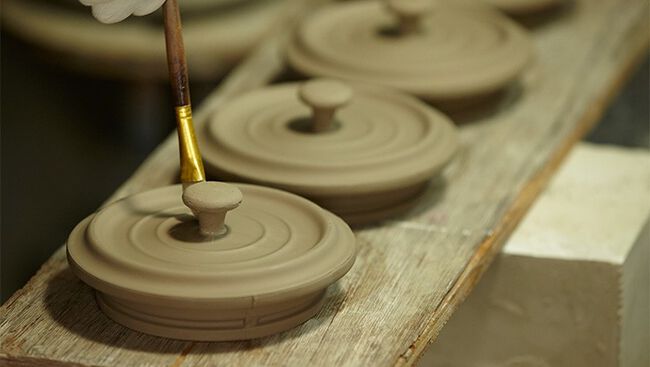- Home
- Magazine
- Product Guide Cookware
- STAUB ceramic manufacturing process

STAUB ceramic production – highest quality and elegance
From the very beginning, STAUB has been dedicated to crafting top-quality cookware. Our products are meticulously crafted from premium materials and undergo rigorous testing to ensure they meet the demands of today's kitchens.

Traditional craftsmanship
Each piece is crafted individually using traditional manufacturing methods. We take great pride in the "Hand Finished" label. Throughout the production process, each piece is meticulously inspected to ensure it meets our high-quality standards. We highly recommend watching our informative video showcasing our manufacturing process.
MATERIAL AND FORM

THE PERFECT START
The foundation of ceramic production lies in the use of premium, organic materials. The caliber of the raw materials and the precise combination of clay and water are imperative factors in achieving a flawless end result.

IN GOOD SHAPE
To ensure consistent quality, every product is crafted with a precise mould tailored specifically for it. Each unique shape is then imprinted with the word "STAUB," symbolizing our commitment to meticulous production and superior quality.
POUR OUT

In one go
The manufacturing technology is determined by the shape of the product. When pouring liquid, it is crucial to precisely portion the clay to achieve accuracy. It is imperative to ensure that the liquid evenly fills each cavity.

Timing
Precise timing is crucial when pouring. The outcome relies on a harmonious combination of skill and expertise.

Handwork
After being poured, the product is lifted from the mould and is now prepared for the next stage of production. Throughout all subsequent processing, each step must be executed with precision.
Die casting

Individual manufacturing process
Some products are manufactured using the die-casting process. This technique allows the product to rest in the mould for longer.

Handwork
Manual production-related corrections require a steady hand and a thorough understanding of the material.

Corrections
Following the initial manual adjustments on the underside, the product is extracted from the mould. This allows for a preliminary inspection of the ceramics. Certain areas of each shape require individual attention during production, necessitating manual corrections.
Rotation method

Portioning
The rotational method is the top choice for creating circular ceramic products. In order to achieve this, the raw material must be accurately measured and divided beforehand.

Shape and positioning
Each product is precisely portioned and placed into the mould before the raw material is prepared for the next step.

Curves
The perfect round ceramic shape is meticulously crafted with an ideal rotation speed and perfect angle.

Auslösen
Nach der Rotation muss das Produkt von Hand aus dem Träger gelöst werden. Hierbei werden auch die produktionsbedingten Korrekturen durchgeführt.

Ruhen
Nach dem Auslösen muss die runde Keramikform ruhen.
Dry

Air
The products are molded and allowed to dry naturally in order to attain the ideal durability for the firing procedure.

DRY SEASON
From experience, each ceramic form needs time to dry to ensure high-quality standards.
Trimming and polishing

Handwork
Hand-tuning is essential for achieving precision in numerous shapes, particularly in intricately designed ceramic pieces. Some products even demand handcrafted detailing for a flawless finish.

Lid
For instance, knobs are typically handcrafted and carefully worked on during the processing stage.

Fine touches
Ultimately, crafting the best possible product requires a steady hand and a keen eye.
COLOR GLAZE

Pigments
The enamel is crafted from a combination of glass powder and colour pigments, resulting in STAUB's distinct and recognizable hues.

DELICATE
When it comes to glazing, handling the process with great sensitivity is essential. This is crucial as the product should not be left in the glaze for a brief or extended period.

Dive
Accomplishing a successful glazing process demands much manual labour and patience. It is crucial to carefully determine the ideal colour edge and tone throughout the process.

Aufgetaucht
Nachdem die Keramik die perfekte Lasur erhalten hat, muss sie wiederholt ruhen und trocknen.
Burning process

Before burning
The ceramic products remain undisturbed, their once vibrant shades fading into soft and delicate pastels. One can only anticipate the vivid STAUB hues that will soon adorn them.

In the oven
The intense heat causes the pigments and clay material to fuse seamlessly, resulting in a flawless blend of colours and glass.

After the kiln
The firing technology greatly enhances the product quality, improving durability, decreasing porosity, and creating more vibrant colours.
Polishing

Final touches
Before storage, our team meticulously hand-finishes each ceramic product to guarantee exceptional craftsmanship and superior quality.

Test
Quality testing ensures that the ceramic products meet the requirements of modern kitchens.

Final check
Before being meticulously packaged, our product undergoes a final inspection before it is prepared for global delivery.
Your account will be deleted!
Notify me when available
This field is required






